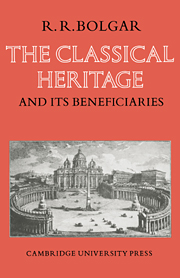Book contents
- Frontmatter
- Contents
- Preface to 1973 impression
- Introduction
- Chapter I The Background
- Chapter II The Greek East
- Chapter III The Carolingian Age
- Chapter IV The Pre-scholastic Age
- Chapter V The Scholastic Age
- Chapter VI Collapse and New Beginnings
- Chapter VII The High Renaissance
- Chapter VIII The End of the Renaissance and the Appearance of New Patterns in Classical Education and Scholarship
- Chapter IX Education and the Classical Heritage
- Notes
- Appendix I Greek MSS. in Italy during the Fifteenth Century
- Appendix II The Translations of Greek and Roman Classics before 1600
- Index
Chapter VIII - The End of the Renaissance and the Appearance of New Patterns in Classical Education and Scholarship
Published online by Cambridge University Press: 29 January 2010
- Frontmatter
- Contents
- Preface to 1973 impression
- Introduction
- Chapter I The Background
- Chapter II The Greek East
- Chapter III The Carolingian Age
- Chapter IV The Pre-scholastic Age
- Chapter V The Scholastic Age
- Chapter VI Collapse and New Beginnings
- Chapter VII The High Renaissance
- Chapter VIII The End of the Renaissance and the Appearance of New Patterns in Classical Education and Scholarship
- Chapter IX Education and the Classical Heritage
- Notes
- Appendix I Greek MSS. in Italy during the Fifteenth Century
- Appendix II The Translations of Greek and Roman Classics before 1600
- Index
Summary
THE NORTHERN RENAISSANCE
The specific achievement of the Humanists, their bringing within the ambit of contemporary knowledge those sectors of the classical heritage which the Middle Ages had failed to explore, was accomplished in two stages. The earlier representatives of the movement, such as Guarino and Erasmus, had written in Latin and the material they had mastered had been accessible only to the learned. It was left to the sixteenth century to contrive the transference of their gains into a more popular medium so that with the rise of the vernacular literatures the New Learning became familiar to all who could read. When that had happened, the absorption of the classical heritage by European culture may be regarded as virtually complete within the limits set by the techniques of the time. The long process we have been following since the seventh century was at an end. But this crowning of a millennium of patient work had an inevitable corollary. Men's attitude to antiquity changed. As the content of the classical literatures became available in the vernaculars and merged in that common background of ideas which is the starting-point of all new thought, the direct study of these literatures lost much of its old interest. The architects of cultural progress had little incentive to concern themselves with the Greek and Latin authors in particular, since most of what these had to offer was already contained within the contemporary tradition. Nevertheless, the study of the classics was too well established to be peremptorily abandoned. Its place in European life was guaranteed by long-standing custom.
- Type
- Chapter
- Information
- The Classical Heritage and its Beneficiaries , pp. 302 - 379Publisher: Cambridge University PressPrint publication year: 1973

